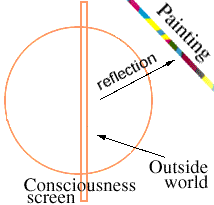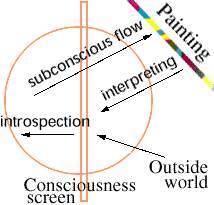Main differenciating characteristics of Analytical Art
What differs Analytical
Art from all the preceding art forms is the move from existing imagery to form-creating with
the involvment of subconsciousness. This actually changes the function of
painting!!!
"Old" function is to picture the existing reality; "New"
function is to present the inner world of the author (not even known by him/her).
Analytical Art teaches its students a secure and productive
way to overcome the barrier of consciousness (without being insane, drug addict
or alcoholic).
Analytical Art combines principles of abstractionism and
figurativity, which never comes across in any other art school.
"Shape-creating"
drawing is a complete contradiction to the academic drawing.
This is an
active, not a passive process (in contrary to drawing from life and copying
it).
Differences in:
Thinking process (the most important)
The main specifics of Filonov's aesthetics
1. Anti-Impressionism! From
the surface, external illusions to the inner essence of processes.
2.
Tension, the meaning of structural functioning. The highest visual concentration
of shapes and content.
3. An attack on the viewer. Agressiveness
of visual means, deformations, visual riddles, contrast colors, estrangements
- all of these are aimed at capturing the viewer's attention.
Pavel Filonov
was convinced that there are no talented individuals, that everybody can be a
master and was willing to offer his time and efforts.
Being a great artist,
Filonov tried to convince his pupils that he was on higher plane than them only
thanks to his experience. When he was asked "Why do you negate talent?", he replied:
"Do you really want to have talent?" Because of that answer one may conclude that
this theory on talent was a pedagogical one; it was in favor of students and against
pride, since snobbery was the root of many evil deeds.
Differences in the process of teaching
The instruction was conducted in a few steps:
1. Mastering of the technique, "technology" of Filonov's painting.
2. Then the training of the mind, deinhibition of the constrained imagination.
Teaching took place in basically one session. Filonov or someone of the group leaders inculcated the others with "madeness", explained the difference between made line, the shape, made at every point, made color, tensely processed on the edges, and the rest - in free improvization.
Next, the most important step was the training of mobility, freedom of the imagination. One had to learn to think, analyze, juxtapose and perform the events and ideas basing on many meanings. Everything depended on sensitivity, intuition, creative initiative of the student. Those who had mastered this system individually were named "Masters".
The folowing work was conducted in realistic, primitivist or abstract manner. The artists worked in different genres. Sketches were prohibited!
He tried to show his students the senselessness of ordinary composing. He drew a head on paper. Thereafter he cut it into several pieces, and all the parts were put together well. He didn't take one thing into consideration: thanks to his own talent he could only cut the picture accurately, but students could not always come up with good compositions despite their efforts to work from the particular to the general. The same thing applied to intuition. By having a very well-developed intuition in visual art, Filonov assumed everybody had the same.
The most important of education process was actually the third, concluding part, in which the student/painter learned to think freely, bravely, analytically, from different points of view and sides, and juxtaposing meanings. If there was a crafty, undeep attitude, then multidimensional system was transformed into surface, outer "technologism".
The Heads of the Academy of Art tried to convince Filonov many times that he should be appointed to be a professor at the Faculty of Painting. But these attempts were to no avail due to his reluctance, since he demanded a refusal of educational programs for the youth based on the artistic waste, such as etudes, sketches and any kind of preliminary work.
Difference in the process of thinking
Filonov viewed the creative process as analytic
in nature, rejecting the notion that it depends on emotional or intuitive inspiration,
and insisting rather on its extraordinary intellectual and even physical aspects.
Filonov's pictorial aims demanded exhaustive attention to detail - a "control"
and "exactness" in the handling of the minutely worked surface of the painting
- in order to realize the goal of "madeness" which he strove to achieve. The physical
presence of the work of art, and the deliberateness of the craft involved in its
production, were intimately bound up with Filonov's notion of content. The lapidary
detail of his intricately build-up forms, and the actual physical process of creating
them on the canvas were - in Filonov's eyes - both a part of the actual substance
of his art.
 Synthetical Art |  Analytical Art |
The specifics of psychological state: maximum relaxation.
Stopping "inner dialog", drawing without thinking of anything special, draw as if it is drawing itself. Analyzing of what was inside your mind will happen when "making" the picture and having the meaningful conclusion out of accidental shapes.
© 1997-2012 Dina Belaia — All rights reserved